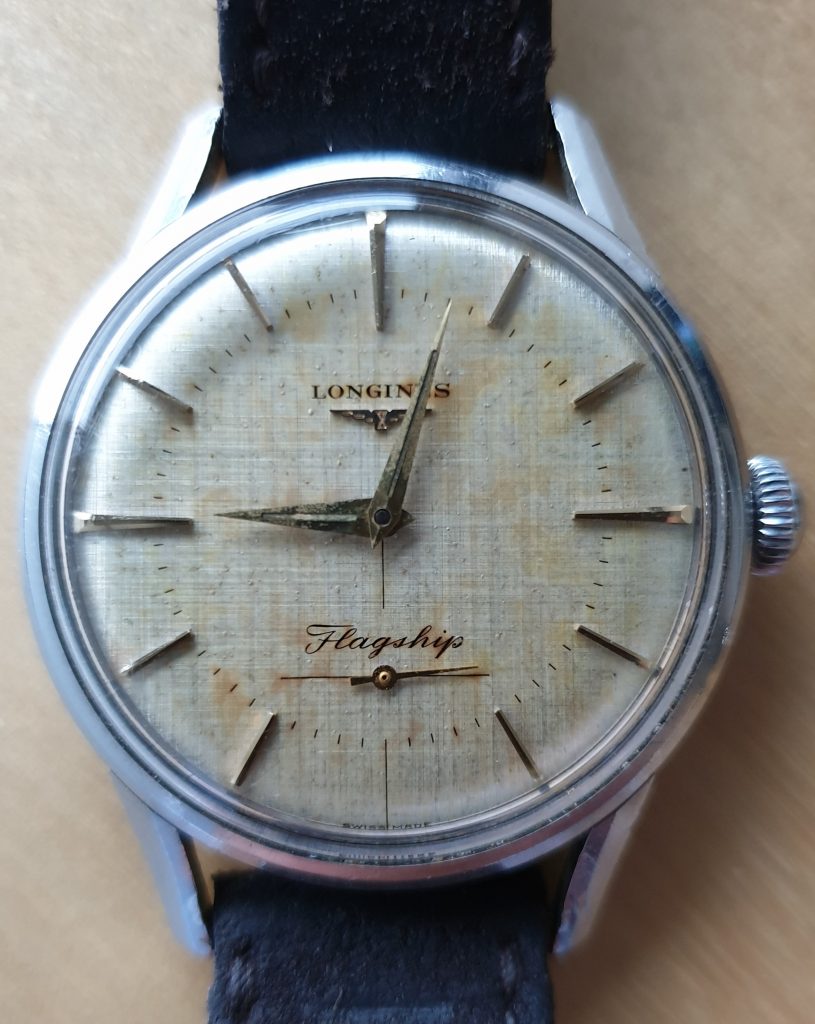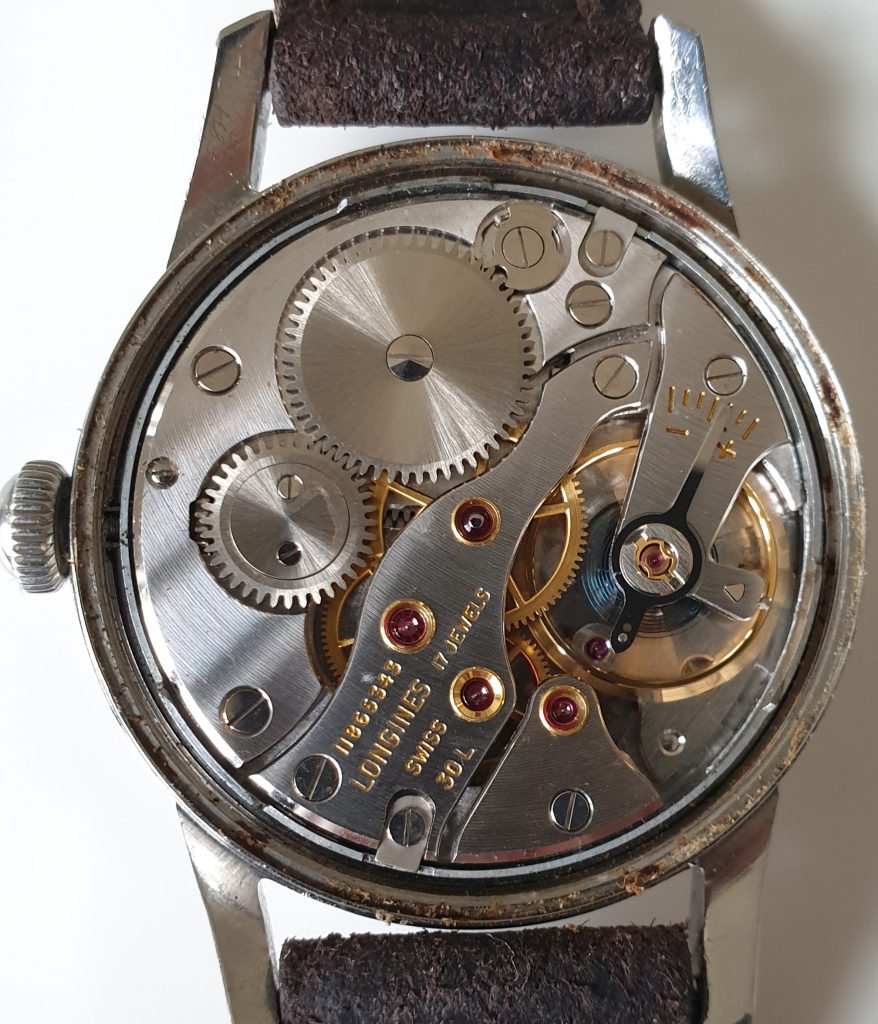| Brand | Longines |
| Model | Flagship |
| Year | 1962 |
| Caliber | 30L Cal nr 11865343 |
| Details | Size 35/10/18 (w/h/lug mm) Serviced by Asferg july 23 |
| Links | A Longines FAN site ! Article on the 30L |
| Search | dba.dk / “Longines” chrono24 / “Longines” |
Longines
..was founded in 1832. Founder Auguste Agassiz was trained in business and worked for a time in the banking industry. In 1832, he and two partners, Henri Raiguel and Florian Morel (who were brothers in law) elected to launch their own watchmaking enterprise as a comptoir in the town of Saint-Imier. The partnership known as Raiguel Jeune & Cie., later to become Longines, was born. Soon after, they established their own assembly facility, thus beginning their move away from the comptoir model.

Eventually both Raiguel and Morel left or retired and Agassiz took control of the comptoir. He was forced into early retirement by poor health in 1850, and brought in his nephew, Ernest Francillon in 1852. While Agassiz remained a partner until his death in 1877, Francillon made numerous changes and modernizations. In 1866, he purchased land south of Saint-Imier and built a factory in an area known as les longines, the long meadows, from where the company eventually took its modern name.
Agassiz had important business connections in America, which soon became a large market for the assembled watches of Raiguel Jeune & Cie., Comptoir. In these early days of watchmaking, typical movements had cylinder escapements and were wound with keys. However, Francillon decided against the key-wound mechanism and beginning in 1867, produced only watches wound via the crown.
And it was in 1867 that Francillon brought in Jaques David to help implement the industrialization which Francillon was so intent on pursuing. David was put in charge of the operation of the new factory – the equipment and mechanical systems. Finally, 1867 was also the year Raiguel Jeune & Cie. Became Longines, named after those long meadows where the new factory was located.
In 1876, Francillon sent a delegation headed by David to the Worlds Fair in Philadelphia, there, they saw what the American watchmaking industry had done with factory manufacturing. The delegation brought home numerous ideas which were implemented in the new factory. In 1880, Longines had created enough production capability to move away from its movement suppliers and create all of its movements in-house.
Moving into the first half of the twentieth century, much of Longines’ renown came from their aviation watches and their continued success with sports timers. They continued to push their expertise in chronographs to more and greater achievements.
Notable calibres and references
Calibre 20A was the first movement produced in the Longines factory in 1867. This 20-line calibre won an award at the Universal Exhibition in Paris that year. It featured an anchor escapement and a pendant winding and setting mechanism. Calibre 20H was Longines first chronograph movement, produced in 1868. The central chrono seconds hand was activated – started, stopped, and rezeroed – via the mono-pusher crown.
Calibre 19.73 debuted in 1890. This double-sided chronograph had a conventional two-register dial in a vertical format on the front, and a double-track tachymeter on the back. The Cal. 19.73N, with its thinner profile, followed in 1909. Eventually this calibre was modified to a split seconds chronograph in 1922. By the beginning of WW II, this design was modified with a more powerful hairspring, yielding a frequency of 50 Hz, and thus capable of measuring elapsed time to 1/100th second.
1936 saw the creation of calibre 13ZN. Multiple versions of this patented calibre were produced, some with a 30 minute counter, others with a 60 minute counter. Calibre 22A was their first automatic movement, released in 1945. 1960 saw the very thin Calibre 340, with an off-center rotor in the 3.45mm thick movement. This kicked off a whole family of new thin movements.
Flagship
In 1957, the first original watch in this new collection by Longines carried high the brand’s standard. Proudly the Flagship symbol decorated the back cover of each watch. It had a wealth of distinguishing technical characteristics and innovative features.
The Longines 30L mechanical movement, used in the Flagship models, was fitted with an “incabloc” device which protected it against shocks and magnetic fields. Thanks to its large balance, the movement could be regulated with perfect precision.
Like many of Longines’ in-house calibres, the quality and care taken in the manufacturing process shines through and though it is a relatively simple calibre.
The first thing to notice is that the jewels for all the train wheels are mounted in “chatons”. A chaton is a ring of soft metal (usually gold) which forms a barrier between the brittle jewel and the hard steel plate. Chatons were used to minimise breakages during installation in the days before jewels could be manufactured to extremely tight tolerances. The continued use of chatons in modern watches is mainly aesthetic as the gold enhances the brilliance and colour of the jewel inside
In 1969, Longines announced its first quartz movement, the Ultra-Quartz, with an analog display. Longines claimed this movement was the first quartz ready for serial production. In 1972 they followed with an LCD digital display watch, which consumed much less power than its contemporaries, the LED watches.
By 1977, the quartz crisis was in full swing, and Longines countered the challenge with Calibre L990. This was a super-slim automatic with two barrels and just 2.95mm thick. In 1979, Longines came out with the “paper-thin” quartz timepiece, the Golden Leaf. This one had an analog display, and measured in at just 1.98mm.
The Longines Column-Wheel Chronograph appeared a few years ago, in 2009. Its engine is the Longines-proprietary ETA calibre A08.231, which Longines calls their L688.
Lindbergh’s Hour-Angle Watch
Lindbergh’s Hour-Angle watch appeared in 1931. It was based on an earlier Longines model which put into practice Philip van Horn Weems’ concepts for a watch to simplify navigation. The Weems watch had appeared in 1927, the same year Lindbergh flew solo across the Atlantic. Its significant feature was a rotatable central dial controlled with a second crown at four o’clock. The dial was marked in 60 equal increments to synchronize running seconds with a transmitted radio time signal.
Lindbergh took what he learned on that transoceanic flight, combined some of Weems’ concepts with new features, and suggested the new watch to Longines. The new watch was 47.5mm in diameter, and both the central seconds dial and the bezel, calibrated in angular degrees, rotated. The watch was used in conjunction with a sextant and a nautical almanac to calculate longitude.
Modern versions of both the Weems Second-Setting watch, and the Lindbergh Hour-Angle watch are available today. Both feature Longines calibre L699, and both measure in at a historically correct 47.5mm.
Participation In Sports Timing
The aforementioned Calibre 19.73, which debuted in 1890, was much of the basis for Longines’ involvement in timing competitive sports. This calibre was modified to a split seconds chronograph in 1922 and eventually, was capable of measuring elapsed time to 1/100th second with the help of a more powerful hairspring.
By 1938, Longines engineers were producing a huge 24-ligne (54.14mm) chronograph movement to be used specifically for sporting events. The principle was larger movement, greater accuracy. Several versions of this calibre followed as well, including one whose balance oscillated at 50 Hz, allowing timing to 1/100thsecond. This timer was produced into the 1970s, by then successfully competing with quartz timers.
Even though Longines developed the quartz-based photo-finish system, “chronocinégines” in 1954, sports officials were more inclined to trust the mechanical timers. Thus, Longines engineers continued to develop the split-seconds chronograph during the 1950s. the result was the calibre 260. The chrono seconds hand circled the dial in 30 seconds, rather than 60, which facilitated the calibre’s ability to time events to 1/10th second.
These days, Longines is known for being the official timer of numerous equestrian, horse racing, tennis, and gymnastics events. These include the United States Triple Crown, and for tennis events like the French Open.
Longevity Of The Logo
Longines winged hourglass logo has been in use in one form or another since 1867. The current Art Deco style version came into use in 1942. The brand name Longines was filed with Switzerland’s Federal Office of Intellectual Property in 1880. The logo was registered with the same office in 1889.


